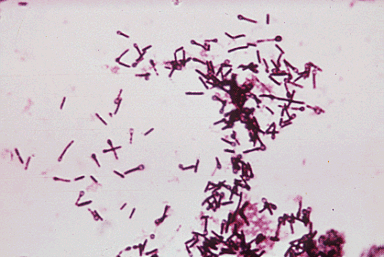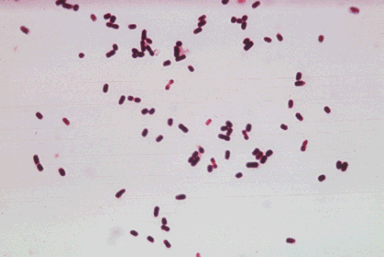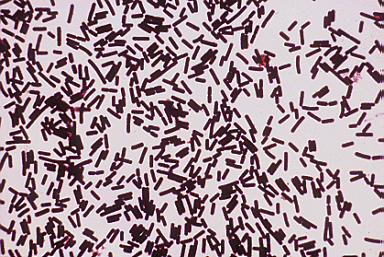CLOSTRIDIUM
CLOSTRIDIUM
Members of genus Clostridium are Gram-positive, spore-forming rods that are anaerobic.
These motile bacteria are ubiquitous in nature and are especially fond of soil.
Under the microscope, they appear as long drumsticks with a bulge located at their terminal ends.
A Gram-stain is a good method for identifying Clostridium because the cell incorporates the dye
while the spore remains unstained. Clostridium shows optimimum growth when plated on blood agar at human
body temperatures. When the environment becomes stressed, however, the bacteria produce spores that
tolerate the extreme conditions that the active bacteria cannot.
In their active form, these bacteria secrete powerful exotoxins that are responsible for such diseases as
tetanus, botulism, and gas gangrene. The four clinically important species of Clostridium will be
discussed here: C. tetani, C. difficile, C. perfringens, and C. botulinum.
C. tetani
(under the microscope)
 Clostridium tetani is the bacterium that causes tetanus (lockjaw) in humans. C. tetani spores can
be acquired from any type of skin trauma involving an infected device. If an anaerobic environment is present,
the spores will germinate and eventually form active C. tetani cells. At the tissue level, the
bacterium then releases an exotoxin called tetanospasmin that causes certain nervous system irregularities by
means of retrograde tramsmission through neurons to the brain. One of the toxin's effects includes constant
skeletal muscle contraction due to a blockage of inhibitory interneurons that regulate muscle contraction.
Prolonged infection eventually leads to respiratory failure, among other things.
If not treated early, the mortality rates of this disease are high. Immunization is the best way to prevent
C. tetani infections in children and adults. The process is started early with the first four shots being
administered within two years of birth. The initial shots are then followed up with periodic booster shots
given every ten years.
Clostridium tetani is the bacterium that causes tetanus (lockjaw) in humans. C. tetani spores can
be acquired from any type of skin trauma involving an infected device. If an anaerobic environment is present,
the spores will germinate and eventually form active C. tetani cells. At the tissue level, the
bacterium then releases an exotoxin called tetanospasmin that causes certain nervous system irregularities by
means of retrograde tramsmission through neurons to the brain. One of the toxin's effects includes constant
skeletal muscle contraction due to a blockage of inhibitory interneurons that regulate muscle contraction.
Prolonged infection eventually leads to respiratory failure, among other things.
If not treated early, the mortality rates of this disease are high. Immunization is the best way to prevent
C. tetani infections in children and adults. The process is started early with the first four shots being
administered within two years of birth. The initial shots are then followed up with periodic booster shots
given every ten years.
LABORATORY INDICATIONS:
- Motile
- Terminal spores
- Non-aerotolerant
C. botulinum
Clostridium botulinum produces one of the most potent toxins in existance and cause of the deadly
botulism food poisoning. Because Clostridium spores can be airborne, they sometimes find their way into
foods that will be placed in anaerobic storage such as cans or jars. Once the jars are sealed, the spores
germinate and the bacteria release their potent toxin. Patients will experience muscular paralysis
as well as blurred vision. Immmediate treatment with an anti-toxin must take
place for the patient to have a chance at survival. Infantile botulism is acquired in a similar manner
but is much milder than the adult version. Honey, however, is the most common source of the spores which
germinate in the child's intestinal tract. Bacterial proliferation and subsequent toxin production cause symptoms
which last a few days and then subside without the use of an antitoxin.
LABORATORY INDICATIONS:
- Motile
- No terminal spores
- Non-aerotolerant
- Lipase +
C. perfringens
(under the microscope)
 This non-motile bacterium is an invasive pathogen that can be contracted from dirt via large cuts are wounds.
C. perfringens cells proliferate after spore germination occurs and they release their exotoxin. The
toxin causes necrosis of the surrounding tissue (Clostridial myonecrosis destroys muscular tissus). The
bacteria themselves produce gas which leads to a bubbly deformation of the infected tissues. C. perfringens
is capable of necrotizing intestinal tissues and can release an enterotoxin that may lead to severe diarrhea.
Treatment of infection can consist of penicillin G (to kill the organism), hyperbaric oxygen (?),
and administration of an antitoxin.
This non-motile bacterium is an invasive pathogen that can be contracted from dirt via large cuts are wounds.
C. perfringens cells proliferate after spore germination occurs and they release their exotoxin. The
toxin causes necrosis of the surrounding tissue (Clostridial myonecrosis destroys muscular tissus). The
bacteria themselves produce gas which leads to a bubbly deformation of the infected tissues. C. perfringens
is capable of necrotizing intestinal tissues and can release an enterotoxin that may lead to severe diarrhea.
Treatment of infection can consist of penicillin G (to kill the organism), hyperbaric oxygen (?),
and administration of an antitoxin.
(under the microscope)

LABORATORY INDICATIONS:
- Non-motile
- No terminal spores
- Non-aerotolerant
- Double zone hemolysis
C. difficile
Clostridium difficile is a motile bacterium that can be part of the natural intestinal flora. Infection
can occur through the use of broad-spectrum antibiotics which lower the relative amount of other normal gut
flora. When this situation occurs, C. difficile proliferates and infects the large intestine. The bacterium
then releases two enterotoxins that destroy the intestinal lining and cause diarrhea. The preferred method
of treatment is vancomycin.
LABORATORY INDICATIONS:
- Motile
- No terminal spores
- Non-aerotolerant




Copyright © 1995 University of Texas - Houston Medical School, DPALM MEDIC, All rights reserved.
 Clostridium tetani is the bacterium that causes tetanus (lockjaw) in humans. C. tetani spores can
be acquired from any type of skin trauma involving an infected device. If an anaerobic environment is present,
the spores will germinate and eventually form active C. tetani cells. At the tissue level, the
bacterium then releases an exotoxin called tetanospasmin that causes certain nervous system irregularities by
means of retrograde tramsmission through neurons to the brain. One of the toxin's effects includes constant
skeletal muscle contraction due to a blockage of inhibitory interneurons that regulate muscle contraction.
Prolonged infection eventually leads to respiratory failure, among other things.
If not treated early, the mortality rates of this disease are high. Immunization is the best way to prevent
C. tetani infections in children and adults. The process is started early with the first four shots being
administered within two years of birth. The initial shots are then followed up with periodic booster shots
given every ten years.
Clostridium tetani is the bacterium that causes tetanus (lockjaw) in humans. C. tetani spores can
be acquired from any type of skin trauma involving an infected device. If an anaerobic environment is present,
the spores will germinate and eventually form active C. tetani cells. At the tissue level, the
bacterium then releases an exotoxin called tetanospasmin that causes certain nervous system irregularities by
means of retrograde tramsmission through neurons to the brain. One of the toxin's effects includes constant
skeletal muscle contraction due to a blockage of inhibitory interneurons that regulate muscle contraction.
Prolonged infection eventually leads to respiratory failure, among other things.
If not treated early, the mortality rates of this disease are high. Immunization is the best way to prevent
C. tetani infections in children and adults. The process is started early with the first four shots being
administered within two years of birth. The initial shots are then followed up with periodic booster shots
given every ten years.
 This non-motile bacterium is an invasive pathogen that can be contracted from dirt via large cuts are wounds.
C. perfringens cells proliferate after spore germination occurs and they release their exotoxin. The
toxin causes necrosis of the surrounding tissue (Clostridial myonecrosis destroys muscular tissus). The
bacteria themselves produce gas which leads to a bubbly deformation of the infected tissues. C. perfringens
is capable of necrotizing intestinal tissues and can release an enterotoxin that may lead to severe diarrhea.
Treatment of infection can consist of penicillin G (to kill the organism), hyperbaric oxygen (?),
and administration of an antitoxin.
This non-motile bacterium is an invasive pathogen that can be contracted from dirt via large cuts are wounds.
C. perfringens cells proliferate after spore germination occurs and they release their exotoxin. The
toxin causes necrosis of the surrounding tissue (Clostridial myonecrosis destroys muscular tissus). The
bacteria themselves produce gas which leads to a bubbly deformation of the infected tissues. C. perfringens
is capable of necrotizing intestinal tissues and can release an enterotoxin that may lead to severe diarrhea.
Treatment of infection can consist of penicillin G (to kill the organism), hyperbaric oxygen (?),
and administration of an antitoxin.




